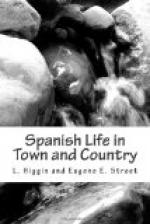Medical science has made great strides during the last ten or twelve years. The hospitals are reformed, and all sanitary and antiseptical arrangements are now strictly attended to, and brought into line with the latest developments of science. A fine new hospital, San Juan de Dios, has been built in Madrid, on the plan of St. Thomas’s in London, and this is only one of many improvements. The reorganisation of all scientific teaching is now engaging the attention of the Minister. An excellent sign of the present state of medical science in Spain—which only a few years ago was so far behind the age—is the fact that the International Congress of Medicine is fixed to meet in Madrid, for the first time, in 1902.
Since the establishment of religious liberty, the Americans seem to have made themselves very busy in missionary work. Mrs. Gulick, the wife of the American missionary in San Sebastian, claims to have “proved the intellectual ability of Spanish girls,” and has secured State examination and recognition of her pupils by the National Institution of San Sebastian, and a few have even obtained admission to the examinations of the Madrid University, where they maintained a high rank. One always has a feeling that missionaries might easily find a field for their zealous labours in their own country; but if an impulse was needed from a foreign people for the initiation of a higher education among the daughters of Spain, they will certainly be able to carry on the work themselves, with such women as Emelia Pardo Bazan to lead the way. Mrs. Gulick is said to project a college for women in Madrid without distinction of creed. The whole affair sounds a little condescending, as though America were coming to the aid of a nation of savages; but if the Spaniards themselves do not object, no one else has any right to do so.
The Protestant movement has made but little progress in Spain. The religion is scarcely fitted to the genius of the people, and the Anglican Church has shown no desire to proselytise a nation which has as much right to its own religious opinions and form of worship as the English nation. The Americans and English Nonconformists are very busy, however, and talk somewhat largely of the results of their labours. In most of the large towns there are English chapels and schools, and a certain number among the lower classes of Spaniards have joined these communities. A private diary of a visit to Madrid so long ago as 1877 describes the English service there. The congregation numbered “quite five hundred.” “They were of the poorer classes of both sexes, with a sprinkling of well-dressed men and women. They seemed to perform their devotions in a spirit of entire reverence and piety, not unlike a similar class in our churches at home. The clergyman delivered an impressive and forcible discourse, chiefly on the honour due to the name of God, and reprobated the profane use of the most sacred names, so common among the Spanish people.... Altogether I look upon the congregation at the Calle de Madera as a nucleus of genuine Protestantism in Spain.”




